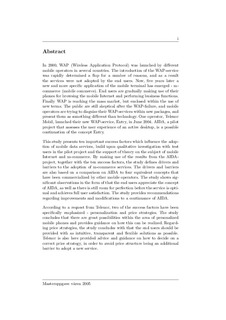| dc.description.abstract | In 2000, WAP (Wireless Application Protocol) was launched by different mobile operators in several countries. The introduction of the WAP - service was rapidly determined a flop for a number of reasons, and as a result the services were not adopted by the end users. Now, five years later a new and more specific application of the mobile terminal has emerged - m-commerce (mobile commerce). End users are gradually making use of their phones for browsing the mobile Internet and performing business functions. Finally WAP is reaching the mass market, but enclosed within the use of new terms. The public are still skeptical after the WAP-failure, and mobile operators are trying to disguise their WAP-services within new packages, and present them as something different than technology. One operator, Telenor Mobil, launched their new WAP-service, Entry, in June 2004. AIDA, a pilot project that assesses the user experience of an active desktop, is a possible continuation of the concept Entry. This study presents ten important success factors which influence the adoption of mobile data services, build upon qualitative investigation with test users in the pilot project and the support of theory on the subject of mobile Internet and m-commerce. By making use of the results from the AIDA-project, together with the ten success factors, the study defines drivers and barriers to the adoption of m-commerce services. The drivers and barriers are also based on a comparison on AIDA to four equivalent concepts that have been commercialized by other mobile operators. The study shows significant observations in the form of that the end users appreciate the concept of AIDA, as well as there is still room for perfection before the service is optimal and achieves full user satisfaction. The study provides recommendations regarding improvements and modifications to a continuance of AIDA. According to a request from Telenor, two of the success factors have been specifically emphasized - personalization and price strategies. The study concludes that there are great possibilities within the area of personalized mobile phones and provides guidance on how this can be realized. Regarding price strategies, the study concludes with that the end users should be provided with as intuitive, transparent and flexible solutions as possible. Telenor is also here provided advice and guidance on how to decide on a correct price strategy, in order to avoid price structure being an additional barrier to adopt a new service. | nb_NO |
